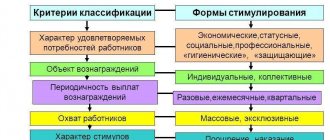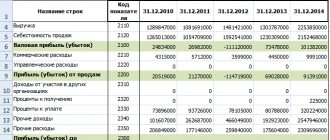How to calculate return on investment? - This question interests every investor. The main goal of investing is to generate income, so it’s always interesting how much you earned and what your profitability is. In terms of profitability, mutual funds, stocks, bonds, deposits, real estate and many other instruments are compared. Any investor, trader or manager is interested in its effectiveness. Banks, management companies and brokers, when advertising their services, like to lure clients with high interest rates. Profitability is one of the most important indicators by which you can evaluate the effectiveness of investments and compare them with other investment alternatives. So, let's figure out what return on investment is and how to calculate it.
Return (rate of return, rate of return) is the degree to which the invested amount increases (or decreases) over a certain period of time. Unlike income, which is expressed in nominal values, that is, in rubles, dollars or euros, profitability is expressed as a percentage. Income can be received in two types:
- interest income is interest on deposits, coupons on bonds, dividends on shares, rent on real estate;
- increase in the value of purchased assets - when the sale price of an asset is greater than the purchase price - these are stocks, bonds, real estate, gold, silver, oil and other commodity assets.
Assets such as real estate, stocks and bonds can combine two sources of income. Calculation of profitability is needed to assess the growth or decline of investments and is a criterion for assessing the effectiveness of investments.
How to calculate return on investment?
In general terms, return is always calculated as profit (or loss) divided by the amount invested multiplied by 100%. Profit is calculated as the amount of the sale of the asset - the amount of the purchase of the asset + the amount of cash payments received during the period of ownership of the asset, that is, interest income.
Formula 1
An example of calculating return on investment.
We bought a share at a price of 100 rubles (investment amount), sold a share at a price of 120 rubles (sale amount), and during the period of holding the share we received 5 rubles in dividends (cash payments). We calculate the profitability: (120-100+5)/100 = 0.25 ∗ 100% = 25%.
Formula 2
There is a second formula, according to which the profitability is calculated as the amount of sale of the asset + the amount of cash payments divided by the amount of investments, minus 1, multiplied by 100%.
Example of profitability calculation: (120+5)/100 - 1 ∗ 100% = 25%.
Why calculate return on investment
First, to answer this question, it is not enough to know the amount of the initial investment. Secondly, the success of the chosen strategy must be assessed based not on absolute numbers, but on the real growth in the purchasing power of the portfolio. The calculation of profitability is carried out to solve two problems:
- comparison of achieved results with target ones;
- forecasting future results.
Your main goal as an investor is not just to make a profit, but to make sure that the strategy you use allows you to beat inflation. In addition, calculating the annual average makes it possible to compare the benefits of investments that differ in size and duration. Having made a forecast of future profitability, you can calculate the amount that will need to be invested regularly in order to achieve your goal within the allotted time.
Analysis of results is as important a component of an investor’s work as the selection of companies for a portfolio. Many beginners do not attach due importance to this issue, but in vain. From personal experience of communicating with readers, I can say that most often the following mistakes are made when calculating profitability:
- reinvestment of dividends and coupons is not taken into account;
- calculations for long-term investments are carried out using arithmetic rather than geometric progression;
- The frequency of account replenishment is not taken into account.
Incorrect calculations often produce inflated results. This makes it difficult to see that the portfolio is bringing virtually no real benefits, and the strategy needs to be adjusted.
How to calculate profitability as a percentage per annum?
The formula for calculating simple profitability does not take into account such an important parameter as time. 25% can be obtained in a month, or in 5 years. How then can one correctly compare the returns of assets whose holding periods differ? To do this, calculate the yield as a percentage per annum . Yield as a percentage per annum is calculated in order to compare the performance of assets with different holding periods. Yield as a percentage per annum is profitability reduced to a single denominator - profitability for the year.
For example, a bank deposit gives 11% per year, and some shares brought 15% for 1.5 years of ownership, which was more profitable? At first glance, the shares, after all, brought more profitability. But the investor owned them for more than six months, so their profitability seemed to be extended over time compared to the deposit. Therefore, in order to correctly compare the deposit and shares, the return on shares must be recalculated as a percentage per annum.
To do this, add the coefficient 365/T to the formula, where T is the number of days of holding the asset.
An example of calculating profitability: We bought a share for 100 rubles, sold it after 1.5 years for 115 rubles. 1.5 years is 1.5*365=547 days.
(115-100)/100 ∗ 365/547 ∗ 100% = 10%. In this case, the deposit turned out to be slightly more profitable than the shares.
Like forex, management companies, brokers and banks manipulate annual returns.
In any advertisement of profitability, pay attention to the footnotes, clarify what profitability is indicated in the advertisement and for what period. For example, the advertisement says the yield is 48% per annum. But it can be received in just one month. That is, the company earned 4% in a month and now proudly advertises a product that gives 4*12=48% per annum. Even you, having earned 1% per day on the stock exchange, can boast that you earned 365% per annum) Only this profitability is virtual.
What is profitability? Formulas for calculating return on investment
The basic return on investment formula looks like this:
The investment amount is the initial investment amount plus additional investments (“top-ups”). Investment profit can consist of the difference between the purchase and sale price of an asset or the net profit of an investment project. This may also include regular payments from sources of passive income (for example, stock dividends).
If the profit is unknown, but you know the initial investment amount and the current balance (the amount of purchase and sale of an asset is also suitable) - use this formula:
Return on investment is measured as a percentage and can serve as a reliable guide for comparing two investment projects. The following example looks very illustrative:
Project A - $1000 profit per year with an initial investment of $5000. Profitability - $1000/$5000 = 20%
Project B - $1000 profit per year with an initial investment of $2000. Profitability - $1000/$2000 = 50%
Obviously, project B is more profitable, since it gives a higher return on investment, despite the fact that the investor’s net profit is the same - $1000. If you increase the amount of investment in project B to $5,000, with a return of 50% per year, the investor will already earn $2,500.
That is, the profitability clearly shows in which project, other things being equal, the investor will earn more. Therefore, an investor with a limited investment portfolio tries to select assets with higher returns.
Calculation of profitability for several investment periods
In practice, there are often situations when investments work for many periods in a row - simple interest (profit is withdrawn after each period) or compound interest (profit is reinvested) begins to work.
Compound interest formulas are designed to ensure that the rate of return always remains constant. But this happens, perhaps, only in banks - much more often the profitability for each new time period will differ. How to calculate the return on investment in this case?
If at the end of each investment period the profit is withdrawn, then everything is simple - add up the returns :
For example, if a project brought 5% in the first year and 10% in the second, then yes, the profitability for 2 years will be 15%. But only on condition of withdrawing profits or covering losses. More often than not, investors don’t bother with this and reinvest the income received. For such situations, the formula for calculating profitability changes - we no longer add, but multiply :
I’ll show you with an example to make it clearer:
The investment project brought 15% in one year, 10% in the second and 20% in the third. Profits are reinvested (compound interest works). What is the final profitability of the project?
Profitability = ((15% + 1)*(10%+1)*(20%+1) - 1) * 100% = (1.15*1.10*1.20 - 1)*100% = (1.518-1)*100 % = 0.518*100% = 51.8%
Using the previous formula, we would get 15%+10%+20% = 45% return. The difference of 6.8% was achieved by reinvesting profits - and if this is not taken into account, you can get very inaccurate profitability indicators.
Calculation of return on investment taking into account inputs and outputs
A task that is more relevant for active web investors - they can shuffle their investment portfolio even more than once a week.
For starters, what are inputs and outputs ? This is any change in initial investment capital that does not result in a gain or loss. The simplest example is monthly replenishment of an investment account from your salary.
Each time you deposit or withdraw funds, the denominator of our profitability formula changes - the amount of investment. To calculate the exact return on an investment, you need to find out the weighted average size of the investment, calculate the return on investment taking into account inputs/outputs, and thus calculate the return. Let's start with profit, the formula will be like this:
All transactions on investment accounts are usually recorded in a special section such as “Payment History” or “Transfer History”.
How to find out the weighted average investment size ? You need to break the entire investment period into parts, separated by input and output operations. And use the formula:
Word doesn’t really want to obey and the formula turned out to be clumsy in appearance. I’ll explain it in simple terms - we count the “working” amount of investments in each of the periods between input and output operations and multiply it by the length of the period (in days/weeks/months) that this amount worked. Then we add everything up and divide by the full length of the period that interests you.
Let's now see how it works with an example:
An investor invested $1,000 in an investment vehicle. After 4 months, the investor decided to add another $300. After another 6 months, the investor needed money, he withdrew $200. At the end of the year, the investment account reached $1,500. What is the profitability of the investment instrument?
Step 1 - calculate the investment profit received:
Profit = ($1500 + $200) - ($1000 + $300) = $400
Step 2 - calculate the weighted average size of investments:
Investment amount = (4*1000$ + 6*(1000$+300$) + 2*(1000$+300$-200$))/12 = (4000$+7800$+2200$)/12 = 1166.67$
Step 3 - calculate the profitability:
Profitability = ($400/$1166.67) * 100% = 0.3429 * 100% = 34.29%
And not 50% if we ignored inputs and outputs - ($1500-$1000)/$1000 * 100% = 50%.
Calculation of average return on investment
Since the profitability of many investment instruments is constantly changing, it is convenient to use some average indicator. Average yield allows you to reduce fluctuations in profitability to one small number, which is convenient to use for further analysis and comparison with other investment options.
There are two ways to calculate average returns. The first is using the compound interest formula, where we have the amount of the initial investment, the profit received during this time, and we also know the number of investment periods:
The initial investment amount is $5000. The profitability for 12 months was 30% (immediately in our mind we translate $5000 * 30% = $1500). What is the average monthly profitability of the project?
Substitute into the formula:
Average return = (((6500/5000)^1/12) - 1) * 100% = ((1.3^1/12) - 1) * 100% = (1.0221 - 1) * 100% = 0.0221 * 100% = 2.21%
The second method is closer to reality - there are returns for several identical periods, you need to calculate the average. Formula:
The project brought 10% profitability in the first quarter, 20% in the second, 5% in the third, and 15% in the fourth. Find out the average profitability for the quarter.
Let's substitute:
Average return = (((10%+1)*(20%+1)*(-5%+1)*(15%+1))^(1/4) - 1) * 100% = ((1.1 *1.2*0.95*1.15)^(1/4) - 1) * 100% = (1.0958 - 1) * 100% = 0.0958 * 100% = 9.58%
One of the special cases of calculating average profitability is determining the annual interest rates , which we encounter at every step in the form of advertising of bank deposits. Knowing the return on investment for a certain period, we can calculate the annual return using the following formula:
The investor invested $20,000 and in 5 months (rounded to 150 days) earned $2,700 in profit. How much is this in percent per annum? Let's substitute:
Profitability = ($2700/$20000 * 365/150) * 100% = (0.135 * 2.4333) * 100% = 0.3285 * 100% = 32.85% per annum
How to calculate average annual return
The tenure of assets can be several years. However, most assets do not grow by the same amount. Assets such as stocks can fall or rise by tens or hundreds of percent per year. Therefore, I would like to know how much your investments grew on average per year. How then to calculate the average annual return? The average annual return is calculated by taking the root using the formula:
Formula 1
where n is the number of years of ownership of the asset.
An example of calculating profitability if we owned the stock for 3 years: 3√125/100 - 1 ∗ 100% = 7.72%
Formula 2
Another formula for calculating average annual profitability is through exponentiation.
The profitability using this formula is very easy to calculate in Ecxel. To do this, select the POWER function, in the Number line enter the quotient of division 125/100, in the Power line enter 1/n, where instead of n enter the number of years, add -1 outside the brackets.
In the cell, the formula will look like this : =POWER(125/100,1/3)-1 . To convert a number to a percentage, select the Percentage cell format.
Was this information useful to you? estimate
Rating 4.6 out of 5. Votes: 5
Profitability or Rate of return (eng. Rate of return) - 1. used in economics (in finance) a relative indicator of the effectiveness of investments in certain assets, financial instruments, projects or business as a whole. 2. Ability, ability to generate income. 3. The ratio of the total cash flows that an asset brings to its price.
Return can often be assessed as the ratio of the absolute value of income to some base, which usually represents the amount of initial investment or the investment that must be made to obtain this income.
Economic literacy - webinar about risk and profitability:
Where: r - profitability; Ve is the final value of the financial asset; Vb is the initial value of the financial asset.
Security yield
The yield of a security is a quantitative characteristic of a security that determines its value for an investor. Profitability depends on the measure of risk. Typically, the higher the yield of a security, the higher the risk. Profitability in general is calculated by the ratio of the profit received by the investor during the ownership of the security to the cost of acquiring it. Profitability is usually determined as a percentage.
The following types of profitability are distinguished:
- Yield to maturity (for bonds)
- Current yield (for stocks and bonds)
- Dividend yield (for stocks)
- Annual Percentage Yield
- Internal Return
Profitability and risk - The essence and methods of measuring profitability
To achieve its main goal - maximizing the wealth of the owners - the enterprise must constantly ensure the investment of available capital in assets that generate the greatest income. In its most general form, income can be defined as the increase in the well-being (wealth) of owners over a certain period of time:
Income for the period = Wealth at the end of the period – Welfare at the beginning of the period
The total amount of income received by the owner of capital consists of two parts: current income and capital gains. For example, having bought an apartment, you can rent it out and receive income in the form of rent. You can live in a purchased apartment and discover after a few years that its price has increased significantly compared to the time of purchase. In the first case, the apartment will generate current income, in the second, income will be received from the increase in the value of the apartment. The owner of an apartment who rented it out can sell it after a few years and thus realize both types of income - current and from the increase in value. Similarly, when purchasing a stock, an investor can expect to receive current income in the form of periodic dividend payments. However, if after some time the market price of the purchased share increases, then he will become even richer by the amount of the increase in value. Thus, the total income from owning the share will be equal to the amount of dividends received on it and the amount of increase in its market value. The income of the bond owner is formed in a similar way. If he purchased a coupon bond, he will receive current income in the form of periodic coupon payments. When purchasing a discount bond, the income is realized in the form of the difference between the sale and purchase prices. These two types of income (current and capital appreciation) can be realized jointly if the interest rate decreases during the period of holding the coupon bond. Coupon payments will remain unchanged, but the market price of the bond will increase, so along with the current income, its owner will also receive income from the increase in the value of the bond.
It is very important to understand that from a financial perspective, both of these types of income are equivalent for the owner and must be taken into account when making calculations. Often the concept of profitability is tied to an asset, financial transaction or enterprise. For example, you can talk about stock return or return on sales. This approach is justified for comparative assessment of the effectiveness of various areas of capital investment: product A may provide more profit than product B, and investments in financial assets may be even more profitable. It should not be forgotten that it is not the assets themselves that generate income, but the capital invested in them. Therefore, it is more correct to talk about return on capital rather than on individual assets or operations. Capital can be simultaneously invested in both real and financial assets, which can generate both current income and increase (or decrease) in their value. The profitability of individual operations will rather reflect the effectiveness of the managers responsible for their implementation - the plant director or stock broker. Total return refers to the entire invested capital, that is, it must be calculated from the perspective of the owner of this capital.
Having capitalized 1 thousand rubles from the total value of his property, the owner has the right to hope for a subsequent increase in his total wealth. Let's assume that 500 rubles out of this thousand were invested in the equity capital of a trading enterprise. The store director, having purchased goods with them, sold them for 750 rubles, that is, the marginal income was 50% (250/500). After deducting the main commercial and administrative expenses, the profit from sales amounted to 100 rubles, that is, the return on sales was 20% (100 / 500). Having covered other operating costs and paid income tax (50 rubles in total), the director reported net profit in the amount of 50 rubles. 20 rubles of this amount were returned to the owner in the form of dividends, and 30 rubles were reinvested in the enterprise.
The second half of the capital (500 rubles) was managed by the broker, who bought securities with this money. By the end of the year, the total income from owning these securities (both current and increase in their value) amounted to 500 rubles, that is, 100%. From this amount, the broker withheld commissions and other expenses, and also paid taxes in the amount of only 300 rubles. That is, the real increase in the wealth of the capital owner was 200 rubles (500 – 300). The total return on all invested capital will be 25% ((20 + 30 + 200) / 1000). As you can see, this value differs from both the return on sales and the return on securities. Evaluating the work of his agents (director and broker), the owner can conclude that the net profitability of the store was 10% (50/500), and the net profitability of financial speculation was 40% (200/500). But neither the first nor the second figures reflect the real total return on the capital invested by him. It is equal to 25%. It is this figure that he should focus on in his plans for the future.
So, speaking of profitability, we should mean the efficiency of using all capital invested by the owner and take into account all net income (in the form of both current payments and capital gains) received by the owner of the invested capital. For analysis, any indicators of profitability (profitability) of assets, operations, projects, etc. can be calculated, but it must be remembered that the most common financial indicator is the total return on invested capital. It is not the assets themselves or operations with them that bring income to the owner, but the capital invested in them.
Profitability is a derivative of the total amount of cumulative net income produced by capital over a certain period of time and the amount of wealth of the owner of capital at the beginning of the period. Since welfare at the end of the period will be equal to the sum of its value at the beginning of the period plus the amount of total net income received by the owner for the entire period, the formula for calculating profitability can be presented as follows:
,
where indices 0 and 1 indicate the beginning and end of the time period, respectively.
The problem of accurately measuring the real value of all property owned by an investor is not directly related to financial management. Therefore, the amount of his wealth at the beginning of the period is taken to be equal to the amount of capital invested by him. The formula for determining the total return for the holding period (holding period return - HPR) can be presented as follows:
where CF is the flow of current income received by the owner from invested capital for the period;
I0 – initial amount of invested capital (investment at the beginning of the period);
I1 – final (accumulated) amount of invested capital (investment at the end of the period);
rC – current profitability;
rI – return on capital gains (capitalized return);
r – total return.
Profitability is one of the main indicators of investments, by which you can evaluate the profitability of investments, their feasibility and compare them with each other according to this indicator. Often, to assess the profitability of investing money, the risk-return relationship is used. The logic here is simple: indicators such as profitability and risk themselves are uninformative. What is the point of investing in instruments with a high level of risk and low potential return? If the risk of loss is high, then the possible reward should be high.
Let us separate the concepts of income and profitability. Income is an absolute value, expressed, for example, in monetary units (Vasya invested 10,000 rubles and received an income of 2,000 rubles), while profitability is a relative value, expressed as a percentage or interest per annum, more on this later (Sasha invested his money in commercial real estate with a yield of 25% per annum).
Profitability calculation formula
Next there will be material with formulas, but don’t be afraid - anyone who studied at school will understand them - they are easy to understand. In addition, your browser must have images enabled, since the formulas are presented in the form of pictures.
The simplest formula for profitability is the ratio of the profit received to the amount of investment, multiplied by one hundred:
You can also calculate the profitability if the initial and final investment amounts are known:
where sum1 is the initial amount, sum2 is the final amount.
However, these formulas do not take into account such an important indicator as time. Over what period is this profitability? In 100 years? Or in 3 months? To take into account the time during which investments have shown profitability, the following profitability formula is used:
where the period in months is the time during which the investment takes place.
The most common period for calculating profitability is 1 year (you don’t have to look far for examples - the same bank deposits are calculated as a percentage per annum).
For example, the owner of an apartment worth $15,000 rented it out at the beginning of the year and received an annual fee from the tenant in the amount of $1,000. By the end of the year, the cost of the apartment increased and amounted to 17 thousand US dollars. The total return on owning an apartment for the year will be 20% (1 + (17 – 15) / 15), including the current return of 6.67% (1 / 15), capitalized return of 13.33% (2 / 15). More precisely, we should talk about the return on capital invested in the purchase of an apartment.
As follows from formula (5.1.1), the amount of profitability is influenced not only by the absolute amount of income received, but also by the amount of investment (I0). In other words, the same absolute amount of income of 1000 rubles will mean a different level of profitability for capital of 10 thousand and 10 million rubles. In the first case, the yield will be 10% (1,000 / 10,000), and in the second - 0.01% (1,000 / 10,000,000). The relative profitability indicator eliminates the influence of the scale factor and more accurately reflects the real financial and economic efficiency of using invested funds than the absolute value of the income received.
Returns always refer to a specific time period. For example, you can earn 1 thousand rubles in a month, or in a year. Even calculating the relative rate of return will not make these figures comparable. If we continue the example and assume that an investment of 10 million rubles brought an income of 1 thousand rubles in 1 week, and an investment of 10 thousand rubles provided the same income in 6 months, then the profitability values obtained above will not be objective enough. To ensure comparability of these indicators, they must be brought to a single time base. In finance, profitability is usually annualized, that is, the original data is annulled. Comparing the formulas for calculating profitability and the formula for the annual interest rate (2.2.1), one can notice their identity. Both the return and the interest rate reflect the rate at which the initial investment grows. By calculating the yield, in essence, the value of the corresponding interest rate is determined.
There are different ways of calculating interest and, accordingly, different interest rates. Accumulation of simple and complex bets leads to different results. What specific rate should be used to determine the annual return? In finance, it is customary to use the effective compound interest rate as a measure of profitability, that is, an annual rate that assumes a one-time reinvestment of accrued interest during the year. However, for short-term financial transactions (lasting less than 1 year), a simple interest rate is allowed. For example, the yield on GKOs was calculated at the simple interest rate (formula 2.2.14) under the assumption that the length of the year is 365 days. Of course, such ambiguity complicates the life of a financier, but the difficulties that arise should not be taken into account as absolutes. First of all, it is necessary to understand that the method of annuity of profitability in no way affects the real parameters of the financial transaction under consideration. Profitability is an abstract indicator used to ensure comparability and comparative evaluation of different capital investments. Therefore, when comparing two investments in terms of their level of profitability, it is important to make sure that the methods for calculating these indicators are comparable. The question of which calculation method is better or “more correct” is not the most important. It is necessary that the same annuity method be used for both operations.
source 1source 2
Calculation of yield to maturity for bonds
Although this is not the main function of the calculator, it can be used quite simply to calculate the yield to maturity for bonds. The yield to maturity for bonds is defined precisely as the IRR of the entire cash flow.
To calculate the yield to maturity, it is necessary to enter the bond purchase amount and planned income in the form of dividends.
The example shows the yield to maturity forecast for a bond with a coupon of 40 rubles (twice a year) and a current value of 98% (980 rubles) and maturity in 2024. The bond is assumed to be held until maturity. In this case, only the last IRR value (at the time of maturity) is relevant, since it is very difficult to predict changes in the bond price. IRR over 6 periods doesn't make much sense for bonds either.
Why keep investment records?
There are several reasons.
The main ones.
You will be surprised, but there are half-traders, half-investors who play on the stock exchange. And it seems like they can do it all. There I closed the deal in the black, here. It got a little burnt out here. Then again. A white streak comes - and profit again.
There was a strong drawdown in the position. It would be a pity to close at a loss. Let's leave (freeze) until better times. Over time, quotes will recover. And it will be possible to get rid of the position.
What's the end result? What is the performance?
The most common answer is “Well, I earn something. Look, I have transaction statistics.”
Let's convert your results over several years into average annual profitability? And we will understand how profitable your strategy is.
And here an unpleasant thing may become clear. It turns out that with all the transactions, broker commissions and other expenses (including periodic freezing of unprofitable positions), the real result is not so impressive. Even some players received lunar or very modest profitability over several years.
The average annual return allows you to evaluate the effectiveness of the strategy used.
The second important point is comparison with the standard (benchmark).
This could be some kind of stock index. Or, for example, risk-free rates on bank deposits or reliable bonds.
Let's say you've calculated everything. They brought out some result. For example, last year you earned 15% per annum. Is it a lot or a little?
Unclear. You need to compare it with something. If you invest in Russian stocks, then your reference point will be the Moscow Exchange index. Or rather, financial instruments in the form of funds (BPIF or ETF).
Buying US stocks? Let's take the corresponding ETF for comparison. For the same S&P 500 index.
And it may turn out that you have an annual profit of 15%, and the corresponding index has grown by 25%.
Or over the last 3 years, through selection and analysis of individual shares, the investor received an average annual return of 12%. And the fund showed an average annual return of 14%.
Spend more time and energy, but get less. Than simply following an index. There is reason to at least think about it. And change something in your strategy.
Nominal, real and effective returns
I have a full course on portfolio investing.
I decided to organize the information from this course into a series of articles. The articles will be useful for those who want to structure investment information. The course touches on the theoretical aspects of investing and practical aspects of investing in the Russian stock market, foreign exchanges and cryptocurrency platforms. Course presentation video:
Let's start the course with theory. If we want to increase or decrease something, then first we need to learn how to measure an indicator. Let's understand the different concepts of profitability.











